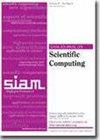基于 BGN 的几何流参数有限元方法的稳定后向微分公式时间离散化
IF 2.6
2区 数学
Q1 MATHEMATICS, APPLIED
引用次数: 0
摘要
SIAM 科学计算期刊》,第 46 卷第 5 期,第 A2874-A2898 页,2024 年 10 月。 摘要我们提出了一类新的时间高阶参数有限元方法,用于求解各种曲线和曲面的几何流。通过将用于时间离散化的后向微分公式(BDF)纳入 BGN 公式,该公式最初由 Barrett、Garcke 和 Nürnberg 提出(J. Comput.物理》,222 (2007),第 441-467 页),我们成功开发了高阶 BGN/BDF[math] 方案。所提出的 BGN/BDF[math]方案不仅保留了经典一阶 BGN 方案的几乎所有优点,如计算效率和良好的网格质量,而且在形状度量方面表现出了理想的[math]三阶时间精度,从二阶精度到四阶精度不等。此外,我们还通过大量数值示例验证了我们提出的 BGN/BDF[math] 方案的性能,证明了它们对各种类型的几何流具有高阶时间精度,同时在整个演化过程中保持了良好的网格质量。本文章由计算机程序翻译,如有差异,请以英文原文为准。
Stable Backward Differentiation Formula Time Discretization of BGN-Based Parametric Finite Element Methods for Geometric Flows
SIAM Journal on Scientific Computing, Volume 46, Issue 5, Page A2874-A2898, October 2024.
Abstract. We propose a novel class of temporal high-order parametric finite element methods for solving a wide range of geometric flows of curves and surfaces. By incorporating the backward differentiation formula (BDF) for time discretization into the BGN formulation, originally proposed by Barrett, Garcke, and Nürnberg (J. Comput. Phys., 222 (2007), pp. 441–467), we successfully develop high-order BGN/BDF[math] schemes. The proposed BGN/BDF[math] schemes not only retain almost all the advantages of the classical first-order BGN scheme such as computational efficiency and good mesh quality, but also exhibit the desired [math]th-order temporal accuracy in terms of shape metrics, ranging from second-order to fourth-order accuracy. Furthermore, we validate the performance of our proposed BGN/BDF[math] schemes through extensive numerical examples, demonstrating their high-order temporal accuracy for various types of geometric flows while maintaining good mesh quality throughout the evolution.
Abstract. We propose a novel class of temporal high-order parametric finite element methods for solving a wide range of geometric flows of curves and surfaces. By incorporating the backward differentiation formula (BDF) for time discretization into the BGN formulation, originally proposed by Barrett, Garcke, and Nürnberg (J. Comput. Phys., 222 (2007), pp. 441–467), we successfully develop high-order BGN/BDF[math] schemes. The proposed BGN/BDF[math] schemes not only retain almost all the advantages of the classical first-order BGN scheme such as computational efficiency and good mesh quality, but also exhibit the desired [math]th-order temporal accuracy in terms of shape metrics, ranging from second-order to fourth-order accuracy. Furthermore, we validate the performance of our proposed BGN/BDF[math] schemes through extensive numerical examples, demonstrating their high-order temporal accuracy for various types of geometric flows while maintaining good mesh quality throughout the evolution.
求助全文
通过发布文献求助,成功后即可免费获取论文全文。
去求助
来源期刊
CiteScore
5.50
自引率
3.20%
发文量
209
审稿时长
1 months
期刊介绍:
The purpose of SIAM Journal on Scientific Computing (SISC) is to advance computational methods for solving scientific and engineering problems.
SISC papers are classified into three categories:
1. Methods and Algorithms for Scientific Computing: Papers in this category may include theoretical analysis, provided that the relevance to applications in science and engineering is demonstrated. They should contain meaningful computational results and theoretical results or strong heuristics supporting the performance of new algorithms.
2. Computational Methods in Science and Engineering: Papers in this section will typically describe novel methodologies for solving a specific problem in computational science or engineering. They should contain enough information about the application to orient other computational scientists but should omit details of interest mainly to the applications specialist.
3. Software and High-Performance Computing: Papers in this category should concern the novel design and development of computational methods and high-quality software, parallel algorithms, high-performance computing issues, new architectures, data analysis, or visualization. The primary focus should be on computational methods that have potentially large impact for an important class of scientific or engineering problems.

 求助内容:
求助内容: 应助结果提醒方式:
应助结果提醒方式:


